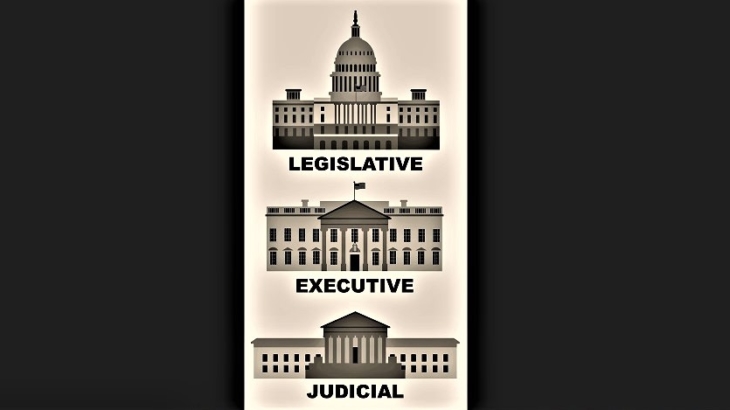Principle of the Separation of Powers, Involving Checks and Balances on Those Powers
 Essay Read by Constituting America Founder, Actress Janine Turner
Essay Read by Constituting America Founder, Actress Janine Turner
The United States Constitution creates a government with three separate branches, each vested with different powers and responsibilities for different functions. This particular structure reflects the doctrine of separated powers. The Framers adopted this doctrine so as to diffuse government power and thereby protect individual liberty from government encroachment. Congress possesses the authority to make laws; the President has the duty of executing those laws; and the courts interpret and apply those laws in cases brought before the judiciary.
By creating three competing branches, the separation of powers scheme uses the power of each independent branch to check and restrain the power of the other branches. In this way, there is a self-executing structure built into the constitutional scheme that restrains any one branch from abusing its power to the detriment of individual liberty.
The Supreme Court has recognized the importance of the separation of powers principle. This principle, according to the Court, “is at the core of American ideology” and is “as fundamental as the vote or representative government.” Separation of powers provides a system of checks and balances, as well as a guard against improvident or impetuous government action. The separation of powers principle seeks to control government power by splitting it among three different functions and branches, with each branch confined to the exercise of its own function and not allowed to encroach on the functions of the other branches.
Separation of powers does more than just accomplish the negative function of preventing abuses of power; it also achieves a number of positive functions. These functions include allowing a wide-ranging political presentation of diverse interests, leading to a broad-based consensus across a diverse republic, as well as promoting the distinctive qualities associated with each branch. Separation of powers helps the government to be deliberative, representative, and accountable. It helps slow down the lawmaking process so that it can be responsive to all the various constituencies in a large democracy. Such a checks-and-balances system makes it more difficult for the government to act unless there is widespread agreement that it should do so.
The separation of powers principle reflects the Framers’ fear of centralized power, which in their experience had led to tyranny. In this respect, the Framers were very much influenced by the earlier writings of French philosopher Baron de Montesquieu, who wrote that “when the legislative and executive powers are united in the same person, or in the same body of magistrates, there can be no liberty.” Throughout its deliberations, the Constitutional Convention remained steadfast in the belief that governmental power should be separated and balanced among the three branches of government, as recommended by Montesquieu.
The Framers foresaw that the separation of powers structure, by placing impediments in the path of the political process, would help to restrain the excesses of lawmaking. Although this structural bias in favor of the status quo would naturally defeat a few good laws, it would even more importantly prevent a number of bad ones.
The judicial enforcement of separation of powers was greatly weakened during the New Deal of the 1930s, when the courts acquiesced in the dramatic expansion of the federal executive branch’s powers and activities. To combat the Great Depression, the New Dealers in President Franklin Roosevelt’s administration significantly expanded the administrative state. This expansion contradicted traditional notions of separation of powers, since the newly empowered administrative agencies combined all three functions in their rulemaking and adjudicative activities. Contrary to the beliefs of the founding era, strong executive government was seen not as a threat to liberty but as a savior of society, and the agents of that saving power were the administrative agencies. But to enable those agencies to perform that role, the Court had to sanction the granting of wide, virtually undefined powers. The Court also had to approve the combination of all three functions within each individual agency. Not surprisingly, the rise of the administrative state meant the corresponding decline of the separation of powers principle.
As a result of the erosion of separation of powers during the New Deal period, the administrative state has grown to the point of being called the “fourth branch” of government. However, contrary to the idealistic hopes of the New Dealers, agencies are often rigidly bureaucratic and cravenly political. But out of perceived necessity for meeting the demands of modern society, the courts have accepted, as a constitutional matter, the administrative state. Moreover, it is perhaps not surprising that – the more the administrative state contradicts separation of powers principles – the more abuses of power and infringements on liberty occur.
 Patrick M. Garry is professor of law at the University of South Dakota. He is author of Limited Government and the Bill of Rights and The False Promise of Big Government: How Washington Helps the Rich and Hurts the Poor.
Patrick M. Garry is professor of law at the University of South Dakota. He is author of Limited Government and the Bill of Rights and The False Promise of Big Government: How Washington Helps the Rich and Hurts the Poor.
Click here for First Principles of the American Founding 90-Day Study Schedule.
Click here to receive our Daily 90-Day Study Essay emailed directly to your inbox.




Join the discussion! Post your comments below.
Your feedback and insights are welcome.Feel free to contribute!